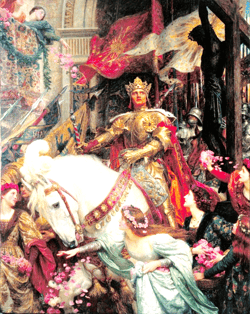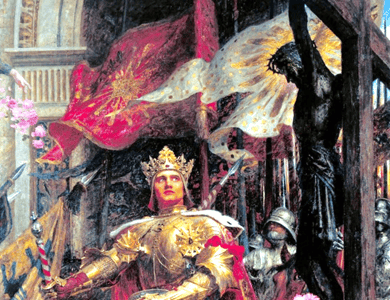The main teaching for our text is: Salvation is something God clothes us with and not something we manufacture.
Isaiah 61 is a highpoint in the closing section of Isaiah (Chapters 56-66). This piece gives abundant opportunities to proclaim the Gospel. Our text begins with the Servant/Messiah’s announcement of His role (verses 1-3) and concludes with a divine promise regarding Zion and the nations (verses 4-10). The forensic nature of justification that is given by the Messiah to the people is a particularly intimate and endearing theological confession you could mine for preaching in this section.
Our entire reading is rich with poetic metaphors about so many aspects of the salvation which the coming Messiah will give. “Beauty for ashes” and the “acceptable year of the Lord” hold together the images of the coronation for a King and a bridegroom/bride-metaphor. The main teaching for our text is: Salvation is something God clothes us with and not something we manufacture. In fact, we brought the ashes to the party, the mourning, the faint spirit, the shame, and the dishonor. In that place, Jesus gives us all His glory, righteousness, salvation, beauty, gladness, and praise.
This reminds me of something Luther said, in The Freedom of a Christian, about the grand exchange which takes place for us in Christ:
“So it happens that the faithful soul, through the wedding ring of its faith in Christ her bridegroom, is free from all sins, secure against death, protected from Hell, and given the eternal righteousness, life, and salvation of her Bridegroom, Christ. Thus, “He takes to Himself a glorious bride without spot or wrinkle... making her clean by washing... in the word of life,”[1] that is, through faith in the word, life, righteousness, and salvation [of Christ]. As Hosea 2[:19] says, [the Lord] becomes engaged to her “in faith, in mercy and compassion, in righteousness, and judgment.” Who can even begin to appreciate this royal marriage? What can comprehend the riches of this glorious grace? Here, this rich, upstanding Bridegroom, Christ, marries this poor, disloyal little prostitute, redeems her from all her evil, and adorns her with all His goodness. For now, it is impossible for her sins to destroy her, because they have been laid upon Christ and devoured by Him. In Christ, her bridegroom, she has her righteousness, which she can enjoy as her very own property. And with confidence she can set this righteousness over against all of her sins and in opposition to death and Hell and can say, “Sure, I have sinned, but my Christ, in whom I trust, has not sinned. All that is His is mine and all that is mine is His.” As it says in the Song of Solomon [2:16]: “My beloved is mine, and I am his.” This is what Paul says in 1 Corinthians 15[:57]: “Thanks be to God, who gives us the victory through our Lord Jesus Christ.” But this “victory” is over sin and death, as he notes in the previous verse [56]: “The sting of death is sin, and the power of sin is the Law.”[2]
What a powerful truth this text proclaims. We receive so much from our Messiah Jesus and He takes on so much just to have us. I wonder if there is a moment, when we who have received so much beauty and a kingdom, would look at what it cost to receive it and be awestruck in wonder. What would happen if we had a glimpse of what it took to take our shame, ashes, and dishonor? Would we be faint again in spirit? Would we mourn even as we rejoice about our new status to think of what it took to have received such grace for life at the cost of our Messiah’s own life on the cross?
When I contemplate what that experience might look like, I think of the amazing painting by Frank Dicksee, called “Two Crowns.”[3]

Here is captured that moment when a ruler at a coronation or wedding looks at the real King of Kings on a cross. Notice how you can almost miss Jesus in the painting because of all the pomp and circumstance going on in front of us. Everyone is looking at the gifts and splendor, but what is the man on horseback staring at? He looks up in shock, humility, and horror at the true King of Kings with no regal splendor or fine gifts. He sees in an ashen silhouette of the one who gave His life for this very moment of splendor and beauty. This regent is struck by the Spirit of the Lord who has come to fulfill Isaiah’s words in more than just a verbal way (Luke 4:16-30). Jesus came to take that word all the way to the cross where He would fulfill it when He cried out, “It is finished” (John 19:30). Then, on the third day, clothed with the early morning sun, God’s only begotten Son of Righteousness would rise again to bring in the victory which would lead us like captives in His train (Ephesians 4:8) as a host of salvation and new life in Him. Furthermore, He gives us the gifts we hear about in our text, which we could never afford or earn, freely giving to us as a Bridegroom gives to His bride. Take a look at the artwork closer this time. Center your attention on this one part of the scene in the painting. Contemplate your place as one who is on the receiving end of Christ’s gifts. Fix your focus on the meaning of the divine exchange, the forensic cost of our justification by grace alone through faith alone on account of Christ shed blood and third day resurrection alone.

For preaching this text using this piece of art, we need to use an “Imagistic Structure” focusing on a “Central Image” where:
“The image serves as a lens through which one views the textual exposition, the theological confession, the evangelical proclamation, and the hearer interpretation of the sermon. Having a single image lends coherence to the sermon.”[4]
With a single focus the image remains the same throughout the sermon. Ours will be on the image of the “Two Crowns,” by Frank Dicksee, which is central and unchanging to the devotional contemplation.
“From this single focus, the sermon can reinforce one theme in a first encounter with the image which will establish the Gospel focus and then, as the image is applied again and again in the sermon, it locates that theme in relation to the text and then, later, in relation to the hearers. By focusing on one part of the image (the look at the crucifix), which remains in the fore of the minds of the hearers, a fresh approach is then created for the listeners through the art on display. As the preacher you are changing how the image is seen, and the hearers are able to track the basic development of a larger theme in the sermon. Each stage of development (for example, moving from a misconception to a clearer vision, moving from application in terms of one’s relationship to God to application in terms of one’s relationship to others) is captured by preaching the image through a different perspective.”[5]
------
Additional Resources:
Craft of Preaching-Check out 1517’s resources on Isaiah 61:1-4, 8-11.
Concordia Theology-Various helps from Concordia Seminary in St. Louis, MO to assist you in preaching Isaiah 61:1-4, 8-11.
Text Week-A treasury of resources from various traditions to help you preach Isaiah 61:1-4, 8-11.
Lectionary Kick-Start-Check out this fantastic podcast from Craft of Preaching authors Peter Nafzger and David Schmitt as they dig into the texts for this Sunday!
-------
[1] A fairly close rendering of Ephesians 5:27a and 26b, leaving out the words “church” and “water.”
[2] Timothy J. Wengert. “The Freedom of a Christian,” in The Roots of Reform, ed. Hans J. Hillerbrand, Kirsi I. Stjerna, and Timothy J. Wengert, volume 1, The Annotated Luther. Minneapolis, MN: Fortress Press, 2015. 501–502.
[3] https://www.arthurchandler.com/two-crowns
[4] https://concordiatheology.org/sermon-structs/dynamic/imagistic-structures/central-image/
[5] Ibid.





